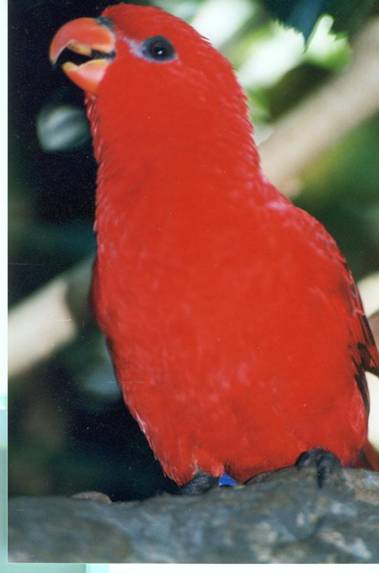Lory - Red
Red Moluccan Lory, Red Lory, Moluccan Lory Scientific Name: Eos bornea bornea
Sat, 19th July, 2025 - 3:35 am GMT
Sponsor Ads:

Alternative Name
Red Moluccan Lory, Red Lory, Moluccan Lory Scientific Name: Eos bornea borneaBasic Info
The Red Lory is quite handsome with its brilliant red plumage. Each of its bright red feathers is tipped with a whitish shaft. The feathers on its secondary and wing covets are tipped with black. Black is the main color for the primaries, but they possess a red speculum. The underside of the tail is a dull red, with the upper side covered in reddish brown plumage. They have an orange bill, with reddish brown eyes. There is no visible difference between males and females. Immature Red Lories have dark eyes and dark bills. They are smaller than many of the larger parrots reaching an average 12 inches (31cm) at adulthood, with wingspans of six to seven inches (160 - 175 mm).
Health
Feed the Lories plenty of fruits and vegetables such as grapes, and make sure that their diet does not consist of a lot of protein because too much protein in a Lories' diet may cause the gout. Citrus fruit should also be avoided. In addition to fruits and veggies fresh water is a must and they should also be given nectar and lory pellets and powder. Some good fruits and veggies include chopped apples, frozen sweet corn, fruit cocktail and leafy green vegetables. Many hobbyists suggest hanging their foods to keep them from being bored. To ensure proper health make sure to clean your Lory's cage daily.Habitat
N/ABehavior
The Red Lory is a beautiful, active parrot that is popular in aviculture, because it is well suited to a variety of homes. The Red Lory, also known as the Moluccan Lory or the Red Moluccan Lory is popular among some hobbyists because it is not as noisy as some other parrot species. This is not to say that they don't make noise. All parrots make noise, it is just a matter of degree. But, on average, this species is quieter than many others, and for this reason it may be more suited to apartment life than some of the other large parrots such as amazons and macaws. The Red Lory is known for its excellent mimicking ability. Their ability to talk, however, is inconsistent at best. While some Red Lories are known to speak this is not the norm and you should not expect your Red Lory to speak. Red Lories are active birds and they need as big a cage as you can afford. They love to play and are great acrobats! Red Lories are also very intelligent. It should be noted that some Red Lories have been known to defecate from the sides of their cages, which can cause quite a mess. Some hobbyists suggest placing acrylic around the edges of the cage to help prevent this from happening. Some Lories are possessive of their toys and cages - for this reason they should be handled frequently, to prevent aggression.Origin
AmboinaHistory
Originating in Indonesia, the Red Lory is commonly seen in Amboina and Saparua.Common Foods
N/ASponsor Ads:
"Science helps a lot, but people built perfectly good brick walls long before they knew why cement works." -- Alan Cox
Lory - Red
Coded by: BGID® | ALL RIGHTS RESERVED Copyright © 2000-2025
Disclaimer | Privacy | Report Errors / Contact | Credits








 Preparing For China. China is growing their military. China Military Technology - can it keep up with the US?
Preparing For China. China is growing their military. China Military Technology - can it keep up with the US?  versus
versus 

 versus
versus 
 This Thread is about the North Korean Military itself - the kind of army, navy, and air force they have.
This Thread is about the North Korean Military itself - the kind of army, navy, and air force they have. 
 versus
versus 
 versus
versus  versus
versus